Inside The New York Botanical Garden
Learning Experiences
Posted in Adult Education, Around the Garden, Learning Experiences, Programs and Events on May 4 2012, by Joyce Newman
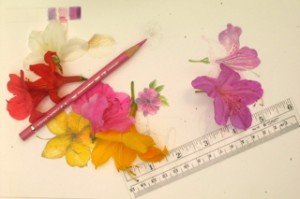 Suppose you really can’t draw, but always wished you could…especially when it comes to drawing those gorgeous blooms in your backyard. Well now’s your chance to make your wish come true: Botanical Drawing I is just one of the new summer intensive classes offered by NYBG starting in July. Think of it as a summer camp experience designed for grown-ups.
Suppose you really can’t draw, but always wished you could…especially when it comes to drawing those gorgeous blooms in your backyard. Well now’s your chance to make your wish come true: Botanical Drawing I is just one of the new summer intensive classes offered by NYBG starting in July. Think of it as a summer camp experience designed for grown-ups.
With the botanical drawing class, in just one week you’ll learn specific techniques for drawing accurately, including professional standards of form, measuring, foreshortening, and perspective. The classes are offered in July (9 through 13) or August (6 through 10), at NYBG and the Midtown Manhattan Center, respectively.
Read More
Posted in Learning Experiences, People on May 2 2012, by Matt Newman
 My only run-in with the legacy of Pythagoras lies in a mathematical theorem: A2+B2=C2. One of those familiar formulas you’re smacked around with in middle school geometry, something most of us had to suffer. (“Suffer” being relative to whether or not you’re as mathematically stunted as I am.) But in the shadow of this Greek philosopher’s lauded contributions to the number game, what else do we find?
My only run-in with the legacy of Pythagoras lies in a mathematical theorem: A2+B2=C2. One of those familiar formulas you’re smacked around with in middle school geometry, something most of us had to suffer. (“Suffer” being relative to whether or not you’re as mathematically stunted as I am.) But in the shadow of this Greek philosopher’s lauded contributions to the number game, what else do we find?
Beans, actually–the same delicious, colorful family of foodie favorites we were talking about only recently. It’s thanks to the obscure (dare we say esoteric?) knowledge of Matthew Wills that we were clued into the rather demented history of the legume.
Bear with me here. I’m not running off on a mad tangent about the piddling dietary habits of a long-dead philosopher. Or maybe I am. It was during Pythagoras’ lifetime as a renowned Greek thinker and teacher that he seeded a bushel of ideas far above and beyond his maths. He also created a religion of sorts. And within the guidelines of that religion, supposed dietary restrictions. I say “supposed” because Pythagoras never wrote anything down himself; it was owed to his followers in succeeding generations that anything the man thought or declared was ever saved for posterity. In and among reflections on the transmigration of the soul and the importance of music, we find the humble bean.
Read More
Posted in Adult Education, Learning Experiences on April 25 2012, by Joyce Newman
Joyce H. Newman is the editor of Consumer Reports’ GreenerChoices.org, and has been a Garden Tour Guide with The New York Botanical Garden for the past six years.
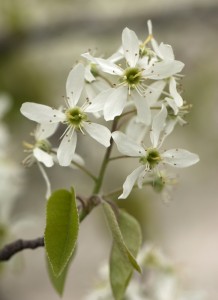 One of the most wonderful native trees in our area is the Shadbush (Amelanchier arborea), which is sometimes called the Serviceberry, Shadblow or Juneberry tree. It’s an all-season beauty, especially in a natural landscape setting, and just one of the many native plants you can learn about in the upcoming class, Gardening with Native Plants.
One of the most wonderful native trees in our area is the Shadbush (Amelanchier arborea), which is sometimes called the Serviceberry, Shadblow or Juneberry tree. It’s an all-season beauty, especially in a natural landscape setting, and just one of the many native plants you can learn about in the upcoming class, Gardening with Native Plants.
The small tree features lovely grey bark and showy flowers, as well as terrific berries for pies and gorgeous fall color. But equally beautiful are the stories and folktales that have been associated with this tree for hundreds of years.
One story is that the first settlers in the New England area often planned funeral services at the same time that the tree bloomed. Its blooming was a sign that the ground had thawed sufficiently to be able to dig graves. So the tree became known as the ‘serviceberry tree.’
Read More
Posted in Adult Education, Around the Garden, Learning Experiences on April 21 2012, by Joyce Newman
 It’s easy to help the planet and explore your greener side with the NYBG‘s programs. There are loads of Saturday and one-day programs offered at the Midtown Education Center in Manhattan and there’s even outdoor Yoga and Tai Chi offered at the Garden in the Bronx.
It’s easy to help the planet and explore your greener side with the NYBG‘s programs. There are loads of Saturday and one-day programs offered at the Midtown Education Center in Manhattan and there’s even outdoor Yoga and Tai Chi offered at the Garden in the Bronx.
Browsing the new Spring-Summer Catalog, you can find one-day and half-day Saturday programs on everything from Beekeeping Basics and Vegetable Gardening, to new Earth-Kind® Roses and terrific Urban Tree Pits. You can discover the healing power of plants or the best choices for a city container garden. Plus, there are a wide range of new cooking classes for romantics to consider, among them, The Art of Cooking in the French Garden–For Couples.
Read More
Posted in Learning Experiences on April 19 2012, by Ann Rafalko
Ed. note: This is a guest post from Andrew Hill, Senior Scientist at Vizzuality, a small company specializing in data, GIS, and the Web. As an organization that is deeply concerned with biodiversity and conservation, the Garden is invested in using technology as a scientific tool, and I feel EcoHackNYC is an event worth sharing with the rest of the New York-area scientific community. If you’re a scientist or researcher, please consider joining this event. — Ann
 This weekend, for the second time in under a year, we are throwing an event to bring together scientists, developers, designers, and others to work collaboratively on environmental projects that matter. We call this event EcoHackNYC. It is a free (un)conference where a small group of people present projects, problems, or data they think need to be developed, and then larger groups of enthusiasts and experts work tirelessly to develop solutions (also check out last year’s event here). For us, this is a special event.
This weekend, for the second time in under a year, we are throwing an event to bring together scientists, developers, designers, and others to work collaboratively on environmental projects that matter. We call this event EcoHackNYC. It is a free (un)conference where a small group of people present projects, problems, or data they think need to be developed, and then larger groups of enthusiasts and experts work tirelessly to develop solutions (also check out last year’s event here). For us, this is a special event.
Read More
Posted in Around the Garden, Gardens and Collections, Learning Experiences on April 8 2012, by Matt Newman
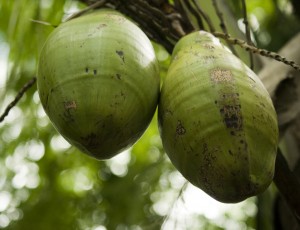 Under the glass of the Enid A. Haupt Conservatory‘s Palm House grows an iconic tree, commonplace to most tourists of the tropics. In the wild, the fruit dangles in lumpy clusters from a familiar silhouette, bending like an elbow toward the sea, a thin pole with a spray of long green leaves at the peak. Visit any beachside farmer’s market in the islands of the Caribbean and you may see the ubiquitous coconut held out in the hands of stall hawkers, a straw stuck through a bored-out husk for passersby to taste.
Under the glass of the Enid A. Haupt Conservatory‘s Palm House grows an iconic tree, commonplace to most tourists of the tropics. In the wild, the fruit dangles in lumpy clusters from a familiar silhouette, bending like an elbow toward the sea, a thin pole with a spray of long green leaves at the peak. Visit any beachside farmer’s market in the islands of the Caribbean and you may see the ubiquitous coconut held out in the hands of stall hawkers, a straw stuck through a bored-out husk for passersby to taste.
But beyond the frosty lip of a piña colada glass, the coconut earns a mixed reputation in the culinary circuit. It clutters cake frosting, makes an appearance in the occasional creme pie, lurks in the most innocuous-looking candy bars–yet how many people do you know who go gaga for the pulpy flesh of this tropical mainstay? I defer to a readily available explanation for the widespread dislike: “It’s not the taste, it’s the consistency.” And with that, I will never again have an opportunity to quote Zombieland, much less Woody Harrelson.
Read More
Posted in Around the Garden, Behind the Scenes, Learning Experiences on March 27 2012, by Amy Weiss
Amy Weiss works in The New York Botanical Garden’s Herbarium, cataloging and preserving plant specimens from around the world.
 Part of my job in the Herbarium of the NYBG is processing plant collections researchers have stored over the years. In general, we only mount plants that have been identified to species. That process can be quick if there is currently a specialist–we send the person a duplicate of a plant collection, and they send us the plant’s name once it has been identified. However, identifying plants to specific species can take much longer if there is no one currently specializing in a certain family or genus.
Part of my job in the Herbarium of the NYBG is processing plant collections researchers have stored over the years. In general, we only mount plants that have been identified to species. That process can be quick if there is currently a specialist–we send the person a duplicate of a plant collection, and they send us the plant’s name once it has been identified. However, identifying plants to specific species can take much longer if there is no one currently specializing in a certain family or genus.
Herbaria are important because they are the depositories of such historical collections, and with our care they will still be around when a specialist is available. Once identified, we mount the plant specimen for New York, and distribute any duplicates to other herbaria around the world. The collections gathered by NYBG scientists that are still waiting for identification reside in our cold room in the meantime, where they will occasionally remain for decades before the right specialist becomes available.
Read More
Posted in Learning Experiences on March 26 2012, by Matt Newman
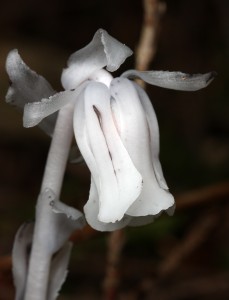 Monotropa uniflora. The scientific name isn’t particularly menacing; it suggests the singular–mono-, uni-. But on a register of local vegetation, you’d likely overlook it. It’s a passing Latin designation in a sea of other plants, many of them named after scientists. And this remains the case up until you get to know this pale, vampiric oddity of the plant kingdom.
Monotropa uniflora. The scientific name isn’t particularly menacing; it suggests the singular–mono-, uni-. But on a register of local vegetation, you’d likely overlook it. It’s a passing Latin designation in a sea of other plants, many of them named after scientists. And this remains the case up until you get to know this pale, vampiric oddity of the plant kingdom.
A friend (one altogether disinterested in botany, strangely enough) happened to post an image and a scientific name on Tumblr the other day. I was hooked from that moment. What was this “plant,” with its ghostly presentation, and what other traits were so interesting that it would distract a chemical engineering student from her studies long enough to share it? With its singular, slumped flower, it looked like a tulip under the cloud of an awful malaise; from petal to stem, there was not a single blush of color.
Read More
Posted in Learning Experiences, Programs and Events on March 19 2012, by Matt Newman
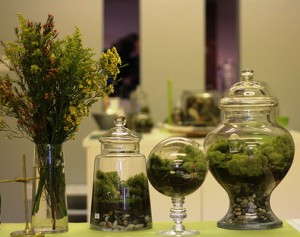 Gardening isn’t always a cakewalk. For New Yorkers, it can be the supreme struggle. Back yard vegetable plots are replaced with cramped fire escape terra cotta, and a window sill planter sits in for the shady garden tree. In light of the trouble with greening a studio apartment the size of your childhood closet, it’s no shock that the terrarium is coming back into vogue. And with Little Landscapes, the valedictorians of terrarium design are bringing the craze to The New York Botanical Garden.
Gardening isn’t always a cakewalk. For New Yorkers, it can be the supreme struggle. Back yard vegetable plots are replaced with cramped fire escape terra cotta, and a window sill planter sits in for the shady garden tree. In light of the trouble with greening a studio apartment the size of your childhood closet, it’s no shock that the terrarium is coming back into vogue. And with Little Landscapes, the valedictorians of terrarium design are bringing the craze to The New York Botanical Garden.
Read More
Posted in Learning Experiences, Shop/Book Reviews on March 16 2012, by Matt Newman
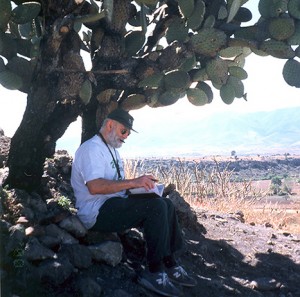 As a world-renowned neurologist and author, as well as a frequent contributor to The New Yorker, Dr. Oliver Sacks suffers no shortage of credentials. And yet, in 2000, an encounter with a group of dedicated fern enthusiasts at The New York Botanical Garden welcomed him into an arena where his relative inexperience proved a boon. Written during a two-week expedition in Mexico, Oaxaca Journal blends the esoteric minutiae of one of the world’s oldest plant groups with an exploration of culture, history, and modern adventure.
As a world-renowned neurologist and author, as well as a frequent contributor to The New Yorker, Dr. Oliver Sacks suffers no shortage of credentials. And yet, in 2000, an encounter with a group of dedicated fern enthusiasts at The New York Botanical Garden welcomed him into an arena where his relative inexperience proved a boon. Written during a two-week expedition in Mexico, Oaxaca Journal blends the esoteric minutiae of one of the world’s oldest plant groups with an exploration of culture, history, and modern adventure.
Oaxaca Journal overcomes the din of scientific jargon through the ease of Sacks’ prose. Even its simplistic approach to storytelling plays to the experience through the self-effacing charm of the author’s pen. His is a travel narrative without any particular direction, admittedly and unapologetically listing sidelong into the native–and at times gritty–reality of Mexican life, just as it charts a course for botanical relevance.
Read More
 Suppose you really can’t draw, but always wished you could…especially when it comes to drawing those gorgeous blooms in your backyard. Well now’s your chance to make your wish come true: Botanical Drawing I is just one of the new summer intensive classes offered by NYBG starting in July. Think of it as a summer camp experience designed for grown-ups.
Suppose you really can’t draw, but always wished you could…especially when it comes to drawing those gorgeous blooms in your backyard. Well now’s your chance to make your wish come true: Botanical Drawing I is just one of the new summer intensive classes offered by NYBG starting in July. Think of it as a summer camp experience designed for grown-ups.








